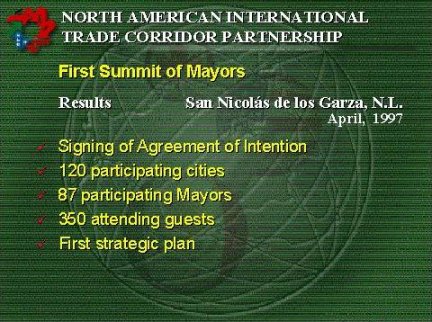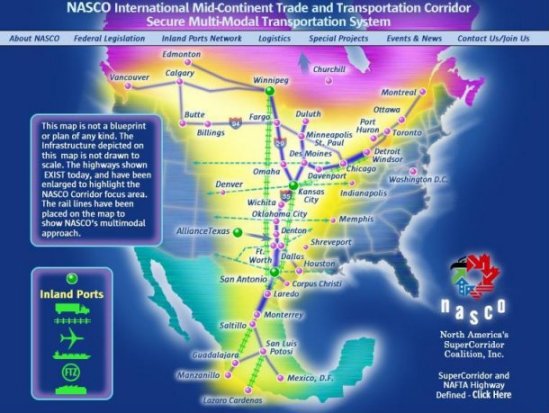Shadow Government
It is not a conspiracy theory to say that the United States has a shadow government. It is a conspiracy fact. It began following World War II with the reorganization of our government to manage post World War II reconstruction. The shadow government is connected to governments and organizations internationally. It is competing with our national government and it threatens the very existence of our nation. The shadow government is run out of the State Department.
The story of the shadow government begins with the United Nations following World War II.
United Nations
The concept of creating a global organization of member states dedicated to preserving international peace through collective security increased in popularity during World War I....
The governments of the United States, the Soviet Union, the United Kingdom, and China formalized the Atlantic Charter proposals in January 1942, shortly after the United States entered the war. In the Declaration of the United Nations, these major Allied nations, along with 22 other states, agreed to work together against the Axis powers (Germany, Japan, and Italy), and committed in principle to the establishment of the United Nations after the war.
Learning from Woodrow Wilson's failure to gain Congressional support for the League of Nations, the Roosevelt Administration aimed to include a wide range of administration and elected officials in its effort to establish the proposed United Nations. The State Department played a significant role in this process, and created a Special Subcommittee on International Organization in the Advisory Committee on Postwar Planning to advise Congress. The subcommittee reviewed past efforts at international cooperation, and by March 1943 had drafted a formal proposal to establish a new, more effective international organization. Secretary of State Cordell Hull took the proposal to members of Congress in an effort to build bipartisan support for the proposed postwar organization. Consultations between Congress and the Department of State continued into the summer of 1943, and by August, produced a draft United Nations Charter. Congress repeatedly passed resolutions declaring its support for the establishment of an international organization--and for United States membership in that organization.
...
At San Francisco, the delegates reviewed and often rewrote the text agreed to at Dumbarton Oaks. The delegations negotiated a role for regional organizations under the United Nations umbrella and outlined the powers of the office of Secretary General, including the authority to refer conflicts to the Security Council. Conference participants also considered a proposal for compulsory jurisdiction for a World Court, but Stettinius recognized such an outcome could imperil Senate ratification. The delegates then agreed that each state should make its own determination about World Court membership. The conference did approve the creation of an Economic and Social Council and a Trusteeship Council to assist in the process of decolonization, and agreed that these councils would have rotating geographic representation. The United Nations Charter also gave the United Nations broader jurisdiction over issues that were 'essentially within' the domestic jurisdiction of states, such as human rights, than the League of Nations had, and broadened its scope on economic and technological issues.
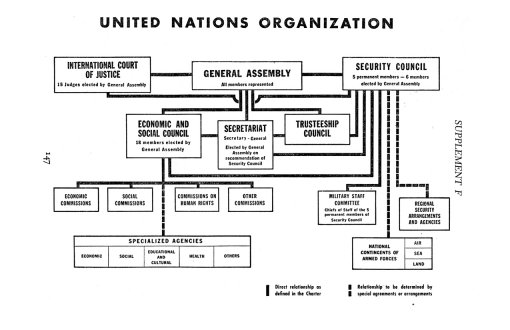
Source: The World
Charter and the Road to Peace
Author: Stuart Chevalier
1946, The Ward Ritchie Press, Los Angeles
National Security Act of 1947
Between 1945 and 1949, the U.S. government was reorganized to create the infrastructure to participate in the United Nations Association and to coordinate international and domestic policy. This infrastructure was coded into law in the National Security Act of 1947 (amended 1949).
The Economic Recovery Act of 1948 better known as the Marshall Plan was passed. The objective of the Marshall Plan was to rebuild Western Europe as an economically integrated region governed by a regional council. It was decided that the U.S. involvement would be through the United Nations rather than direct management by the U.S. government. The Policy Planning Staff of the State Department was the liaison between the United States and the United Nations - coordinating domestic policy with the United Nations initiatives.
The National Security Act of 1947 mandated a major reorganization of the foreign policy and military establishments of the U.S. Government. The act created many of the institutions that Presidents found useful when formulating and implementing foreign policy, including the National Security Council (NSC). The Council itself included the President, Vice President, Secretary of State, Secretary of Defense, and other members (such as the Director of the Central Intelligence Agency), who met at the White House to discuss both long-term problems and more immediate national security crises. A small NSC staff was hired to coordinate foreign policy materials from other agencies for the President...
The act also established the Central Intelligence Agency (CIA), which grew out of World War II era Office of Strategic Services and small post-war intelligence organizations. The CIA served as the primary civilian intelligence-gathering organization in the government. Later, the Defense Intelligence Agency became the main military intelligence body. The 1947 law also caused far-reaching changes in the military establishment. The War Department and Navy Department merged into a single Department of Defense under the Secretary of Defense, who also directed the newly created Department of the Air Force. However, each of the three branches maintained their own service secretaries. In 1949 the act was amended to give the Secretary of Defense more power over the individual services and their secretaries.
The Policy Planning Staff of the State Department was the organization that created and managed the Marshall Plan Blueprint:
Mission Statement
Fusing Thought With Action: The Mission and Purpose of the Policy Planning Staff
Created in 1947 by George Kennan at the request of Secretary of State George C. Marshall, the Policy Planning Staff (S/P) serves as a source of independent policy analysis and advice for the Secretary of State. The Policy Planning Staff's mission is to take a longer term, strategic view of global trends and frame recommendations for the Secretary of State to advance U.S. interests and American values.
In his memoirs Present at the Creation, former Secretary of State Dean Acheson characterized the role of Policy Planning: "To anticipate the emerging form of things to come, to reappraise policies which had acquired their own momentum and went on after the reasons for them had ceased, and to stimulate and, when necessary, to devise basic policies crucial to the conduct of our foreign affairs."
Excerpts from a State Dept article titled, "The Marshall Plan, A Strategy That Worked":
"Kennan and his new State Department Policy Planning Staff produced one of the master documents from which the Marshall Plan eventually flowed.... But there was a specifically European dimension to the Marshall effort. Europe's evil genie, said people like Kennan, Assistant Secretary of State Dean Acheson, and future ERP Ambassador Averell Harriman, was nationalism. If that root of Nazi-fascism and other 20th-century rivalries could be bottled up in an integrated European economic framework, the resulting prosperity might dampen nationalist competition, prevent future armed conflicts, and obviate U.S. involvement in future European wars."
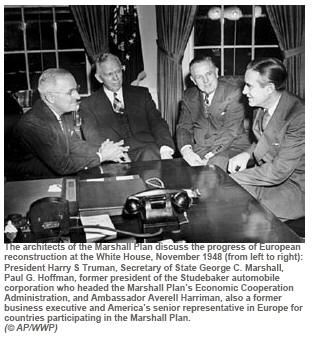
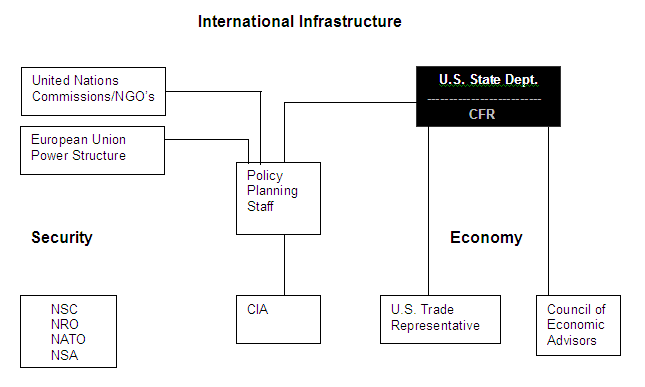
by Francisco Gil-White
Did the National Security Act of 1947 destroy freedom of the press?
"The National Security Act (passed in 1947) allows US Intelligence to begin any action, at any time, without asking anybody. In addition, US Intelligence may postpone indefinitely any report of such activity simply by claiming that making the report would harm the "national security" of the United States. This is a recipe for absolute power. It follows that the National Security Act of 1947 gave US Intelligence the power -- if not the explicit authority -- to corrupt the press in secret. This article will argue, and document, that this is precisely what US Intelligence has done. Naturally, this raises the sharpest possible questions about the integrity of US democracy." [More]
The above is no doubt the reason that the newspapers never cover any information about the United Nations except as it pertains to the Security Council. It's the other side of the United Nations - the social and economic programs that must be looked to be able to see the parallels between what is perceived to be the domestic agenda in the United States and the international agenda as voted on by the Komintern of the UN.
Regionalism
"We cannot leap into world government in one quick step … The precondition for eventual globalization - genuine globalization - is progressive regionalization. Because thereby we move toward larger, more stable, more cooperative units." Zbigniew Brzezinski , former USNational Security Adviser (1977-1981) 1995
The State Department is charged with the task of ensuring U.S. compliance with international agreements. Since they have no authority on U.S. territory or anybody's territory for that matter, the way they have subverted governments both here and abroad has been through regionalization. Regionalization is a strategy of power stripping from elected representative government - transferring it to unelected, virtually invisible regional entities - commissions, associations, etc. The regional organizations cross jurisdictional boundaries county/city/town/state stripping elements of the governing power from each jurisdictional unit. It's the regional entities that are the shadow government. The shadow government obtains power either through agreements that sign over governing authority to the regional entity or by Memorandum agreeing to go along with the betrayal of their constituents as in the case of this treasonous Memorandum of Understanding signed by Governor Dirk Kempthorne: Treason by Memo.
The first regional organizations that I'm aware of were the Municipal Planning Organizations. The purpose of the MPO's were to plan the on and off ramps for the interstate highway system.
Metropolitan Planning Organizations (MPO)
The Federal-Aid Highway Act of 1962 came with the requirement for urban transportation planning for metropolitan areas - defined as having a population of 50,000 or greater. Evolution of the comprehensive planning process:
"By July, 1965, all the 224 existing urbanized areas had an urban transportation planning process underway. At that time, qualified planning agencies to conduct the transportation planning process were lacking in many urban areas. Therefore, the Bureau of Public Roads (predecessor to the Federal Highway Administration) required the creation of planning agencies or organizational arrangements that would be capable of carrying out the required planning process. Hence, Metropolitan Planning Organizations (MPOs) quickly came into being because of the growing momentum of the highway program and the federal financing of the planning process."1
The Federal Highway Administration defines MPO6 as follows:
1) Regional policy body, required in urbanized areas with populations over 50,000, and designated by local officials and the governor of the state. Responsible in cooperation with the state and other transportation providers for carrying out the metropolitan transportation planning requirements of federal highway and transit legislation. 2) Formed in cooperation with the state, develops transportation plans and programs for the metropolitan area. For each urbanized area, a Metropolitan Planning Organization (MPO) must be designated by agreement between the Governor and local units of government representing 75% of the affected population (in the metropolitan area), including the central cities or cities as defined by the Bureau of the Census, or in accordance with procedures established by applicable State or local law (23 U.S.C. 134(b)(1)/Federal Transit Act of 1991 Sec. 8(b)(1)). (FHWA2)
Education
In 1965, the Interstate Compact for Education was drafted establishing the 'Education Commission of the States (ECS)'. It was the beginning of "creeping nationalization" of our schools through the backdoor. All of the states signed the Compact. Title 33, Chapter 41 Interstate Compacts is the Idaho law that calls for cooperation with the Education Commission of the States (ECS).
The Interstate Compacts law called for an appointed Education Council giving the Governor the power to appoint the Chairman and the majority of members. This took the power and responsibility away from local elected school board officials and gave it to the governor. This has been the way that the 'one-size fits all', national and international agendas have been implemented in our schools.
Regional Centers for Education - Institutional Infrastructure
Also in 1965, ten regional centers were established to disseminate and manage the national agenda for local education. And apparently within the regional centers, "Comprehensive Centers" were established to assist schools with the implementation of the 'No Child Left Behind' Act of 2001. The Comprehensive centers are harmonizing the curriculum and administration with the national computer system for monitoring, measuring and control. Regional Laboratories are run by Contractors.
North American Union - Regional Governance
As mentioned above, the covert mission of the U.S. State Department Policy Planning Staff was to create a European Union - United States of Europe. They began the same effort to create a North American Union comprised of the United States, Canada and Mexico in 1982 when the U.S.-Mexico Binational Commission was established. In 1983, President Ronald Reagan signed the La Paz Agreement to create an international zone on the U.S. Mexican Border under the leadership the U.S. EPA Director - but managed by the U.S. State Department under their authority to manage international agreements.
International Zone Created by the La Paz Agreement

This agreement was written in a wide open way that allowed EPA coordinator to expand the areas of responsibility. There are now 10 working groups listed by the 'Security and Prosperity Partnership' website. The SPP website declared their launch date was 2005, but that's not true. That's just the date that the 3 traitor amigos - Bush, Fox and Martin issued the joint statement on the 'Security and Prosperity Partnership' which is just a deceptive name for the North American Union. The SPP is the American side of the U.S.-Mexico Binational Commission as evidenced by remarks by Condasleeza Rice in a meeting with Foreign Secretary Derbez of Mexico.
SECRETARY RICE: Good afternoon. I am delighted to welcome Foreign Secretary Derbez of Mexico. We have just completed a meeting of the Binational Commission between the United States and Mexico, a Commission that has been in place for 22 years now. The Minister and I have not been here for 22 years of the Commission. Indeed, it is my first as Secretary but, Luis Ernesto, you've had several as the Secretary -- Foreign Secretary for Mexico. We were joined also by Mike Chertoff, Homeland Security Secretary here in the United States and by Minister Abascol and Minister Medina Mora from Mexico.
This Binational Commission looks at a range of issues. There are indeed ten working groups of this Commission that examine the full range of relations and issues between the United States and Mexico. It is, of course, a relationship that is deep and broad, based on common values, but also a relationship in which there is a lot of contact between our people in which there are day-to-day issues of trade and prosperity and migration to be dealt with. And so this Commission provides an opportunity for the secretaries to get together and to review the progress that we're making on systemic answers and resolutions of problems that exist in our relationship. But we're always able to do so on the basis of friendship, on the basis of colleagueship, with respect for each other and a deep desire to have our people live in peace and prosperity and to share these borders in a way that makes us both more secure and more prosperous.
In 1986, the U.S. and Canada signed a similar environmentally based agreement covering transnational shipments of hazardous waste also managed by the EPA.
In an effort to ensure appropriate oversight of transboundary movement of wastes, the U.S. and Canada signed an Agreement between the Government of Canada and the Government of the United States of America Concerning the Transboundary Movement of Hazardous Waste and Other Waste. Although the original 1986 Agreement only addressed hazardous waste, the U.S. and Canada agreed in 1992 to expand the scope of the Bilateral Agreement to include MSW (and the ash resulting from its incineration), referred to as "other waste," and to implement the notice and consent provisions for MSW once each country obtained the necessary authorities.
The U.S.-Canadian Bilateral Agreement creates a blueprint that allows U.S.-Canadian shipments to move across the border and be managed in an environmentally safe way. Specifically, the Bilateral Agreement establishes a detailed procedure for national government-to-government notice and consent. This process begins with a potential exporter notifying its government of its intent to export a waste shipment. Having received this information, the environmental agency of the exporting country will then forward this notice of intent to export a waste shipment.
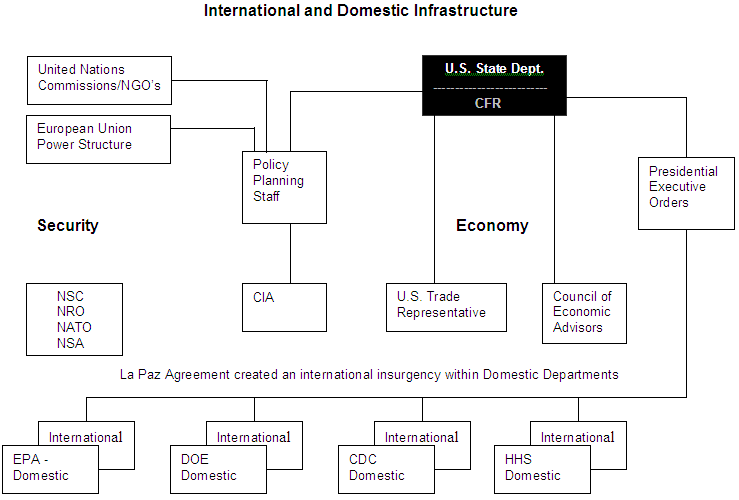
An example of how the shadow government works is Executive Order 12852. In June of 1993, President Bill Clinton signed Executive Order 12852 calling for the creation of the President’s Council on Sustainable Development. Though the United Nations and Agenda 21 are not mentioned in the Executive Order, it is well known now that ‘Sustainable Development’ and Agenda 21 are the same. The Congress never voted on whether to implement UN Agenda 21. It was just ordered implemented by Clinton. It is through this circuitous route that the international Komintern’s agenda is implemented in the United States while maintaining deniability for Congress even though they vote for the funding. That's not just my opinion.
The EPA started the Smart Growth network that has infiltrated our communities all over the country. They provide grants to these groups to act as local pressure groups and they bring professional facilitators with them to bamboozle the locals into accepting the edicts masked as ideas. This is covert gang warfare against the locals and it is the communist system.
The PCSD invited "stakeholders" which included City Mayors and County Officials to participate. Then in 1998, the EPA established the "The Sustainable Development Challenge Grant program. The grant program provided the 'buy-off money' to get local officials to participate. This strategy was a cannibalizing force to change the mindset of city officials away from thinking as entities of the United States as a nation towards thinking in terms of regions and international cities.
In May of 1999, the PCSD published a report, 'Towards A Sustainable America: Advancing Prosperity, Opportunity and a Healthy Environment for the 21st Century". The purpose of the report was to present the ideas of the Council and supposedly of the "stakeholders" for implementing 'Sustainable Development' in the U. S. In the listed goals, Goal 9 was "International Responsibility". Chapter 5 contains the detail which includes encouraging city and county officials to become involved at the international level.
Subversive Regional Transportation Planning
The Intermodal Surface Transportation Act of 1991 called for the planning of an international highway and it provided the grant money to universities for development of the 'Intelligent Vehicle Highway System' - which not coincidently is also perfectly suited for a military surveillance and control of supplies and movement system. The CANAMEX corridor was to have been the first corridor, but the NASCO coalition was particularly effective at lobbying for the Trans-Texas Corridor especially after they merged with the North American International Trade Corridor Partnership.
North American International Trade Corridor Partnership
George D. Blackwood, a city official of Kansas City Missouri was one of the Founders of the NAITCP. According to the now retired NAITCP website, the NAITCP was a partnership of cities of Mexico, the United States and Canada.
KC SmartPort with the Mexican customs facility project was championed by David W. Eaton, president of Monterrey Business Consultants in Monterrey, Mexico, and the former executive director of NAITCP. IRPP Working Paper No. 2004-09j
Could any of this have been done without the state department? Clearly not. Above, I showed how the shadow government was established - corrupting U.S. domestic agencies of government. The Federal Highway Department Joint U.S./Mexico Border Transportation Planning is case in point of the shadow government in operation and how they are subversive to American domestic interests. Treason by Memo.
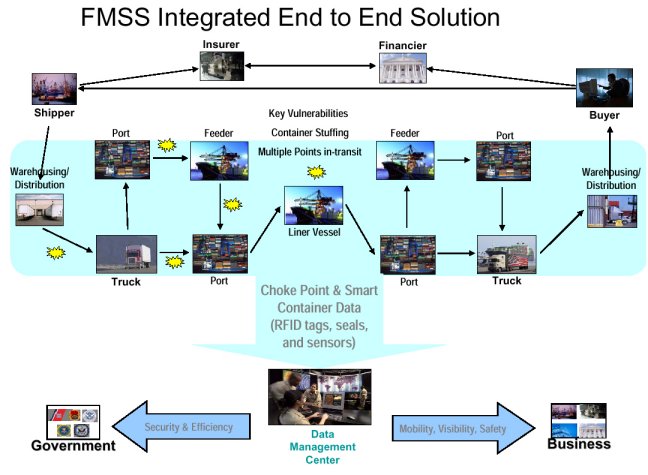
State International Partnerships
The Pacific Northwest Economic Region is a regional organization that includes the following states and provinces: Alaska, Idaho, Montana, Oregon, Washington, Alberta, British Columbia and Yukon.
As a resident of Idaho, I've seen subtle propaganda - commercials by a pressure group making fun of Wisconsin cheese heads. I was unaware of the PNWER at the time, but the commercials were offensive enough that I twice wrote emails to them complaining about the commercials. Now, being aware of the PNWER and the agenda, clearly the commercials are subversive to the cohesion of the United States and they are being used to attempt to create a regional loyalty - breaking U.S. national loyalty.
"The Pacific NorthWest Economic Region (PNWER) is a regional U.S.-Canadian forum dedicated to encouraging global economic competitiveness and preserving our world-class natural environment. PNWER is recognized by both the United States and Canada as the “model” for regional and bi-national cooperation because of its proven success. PNWER is a respected voice and resource for our region, and provides the public and private sectors a cross-border forum for unfiltered dialogue that capitalizes upon the synergies between business leaders and elected officials who work to advance the region’s global competitiveness.

"We are China and East Asia's gateway to North America" PNWER
Global Government Information System
In 1990 at the G8 Summit in Houston, the decision was made to internationalize our financial system. In 1991, Senator Al Gore succeeded in ushering through the legislative process, the 1991 High Performance Computing Act which provided funding for the build out of the Internet and making it available to the public and the business community at large. When Clinton and Gore were elected in 1992, Gore proceeded with the Internet agenda which included plans for government "efficiency" by implementing web-based information kiosks as well as working on the design for nationalized medical records in preparation for a federal takeover (unknown then... known now) of our health care system. The national plan for Internet access turned out to be a bait and switch and the real plan for harmonized, synchronized global government systems was revealed. In 1995, the G8 made the decision for eleven global systems which included eGovernment.
The global information systems are the weapon and the tools of the shadow government. They expect to be able to manage and control the entire population of the world and their utilization of resources using computer systems, sensor and surveillance systems. It's now or never to stop these treacherous psychopaths of the shadow government(s) who have been terrorizing the people of the world since before World War II.
Vicky Davis
January 21, 2010
